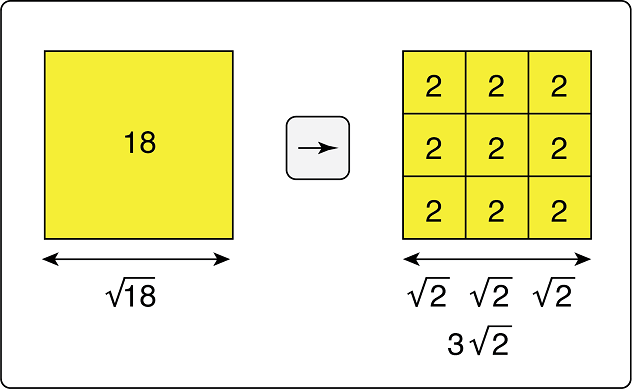I have recently been using some of the ideas in Tina Cardone’s book Nix the Tricks. Research evidence shows that whilst teaching students tips and tricks may work in the short term, this method makes mathematics more difficult to remember long term.
Nix the Tricks considers common tricks and presents alternative methods of teaching topics to encourage mathematical understanding.
Something that really impresses me with Nix the Tricks are the links made between the arithmetical processes and geometrical representations. I particularly like the way that writing a number in surd form is tackled.
From an arithmetic perspective, writing √18 in surd form begins by looking for the largest perfect square that is a factor of 18. This gives √18 = √9x2 = √9 x √2 = 3√2
Here is a corresponding geometrical representation:

The square root function asks for the side length of a square with a given area. For √18, we are looking for the side length of a square with area 18 square units. Dividing the square into nine smaller squares gives the side length of each small square as √2 and it takes three small squares to span one full side, hence:
√18 = 3√2
Initially, I got students working on examples where they were given the number of smaller squares. The next step involved presenting them with the challenge of drawing their own diagram, restricting the solution to examples with either 4 or 9 small squares. In these instances, the geometrical method proved to be a very efficient way of writing numbers in surd form. The thing that really struck students who used this method was how important squares are in finding square roots.
A discussion on writing √162 in surd form revealed that many students had deduced for themselves that they needed to find the largest square factor of 162. This naturally led on to looking at prime factor trees and picking out repeated factors. Throughout this process, students were able to link the process back to the geometrical representation.
Find out more
We have recently added the Nix the Tricks book both in its entirety and divided into chapters to our online resource collection. Further resources in this area can be found in this SMILE resource that contains two packs of games to support the teaching and learning of powers and roots.
You can also join us at the National STEM Learning Centre to experience ideas for teaching through understanding on the following bursary-supported CPD activities.


